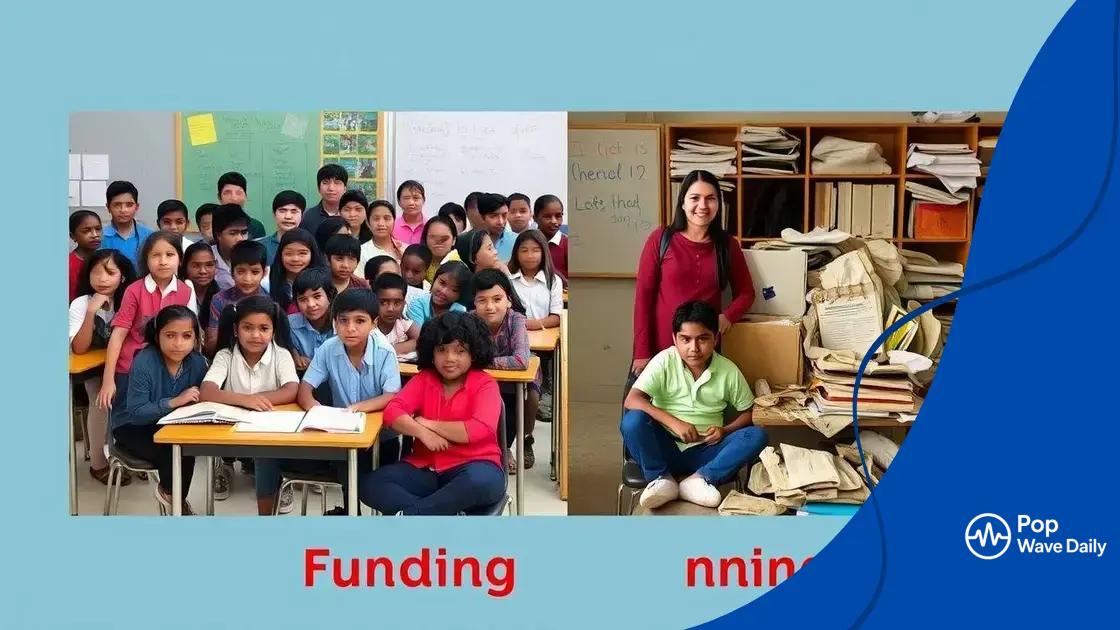School funding allocation debates: why they matter

Anúncios
School funding allocation debates center on how resources are distributed among schools, highlighting issues of equity, accountability, and community involvement to ensure all students receive adequate support and opportunities.
School funding allocation debates are essential in shaping the educational landscape. Have you ever wondered how budget decisions affect your local school? Let’s dive into why these discussions are so important.
Anúncios
Understanding school funding allocation
Understanding school funding allocation is vital to grasp how resources are distributed in education. Every child deserves access to quality education, but funding discrepancies can create significant challenges.
Currently, schools receive funds from various sources, including local, state, and federal governments. The amount of funding can lead to different educational outcomes. To better comprehend this system, it is essential to explore the mechanisms behind funding allocation.
Funding sources for schools
The primary sources of funding that schools rely on include:
Anúncios
- Local property taxes: These are the main funding source in many districts, heavily influencing the budget based on community wealth.
- State appropriations: This funding is distributed through state-level budgets, often aimed at equalizing resources across districts.
- Federal grants: While they constitute a smaller portion, federal funds are crucial for special education and low-income students.
Understanding these sources helps highlight why funding is uneven across different schools. The rich vs. poor debate is exacerbated when districts depend on local taxes. Consequently, students in wealthier neighborhoods often benefit from better facilities and resources.
Problems with current allocation methods
Unfortunately, the current methods lead to significant disparities. Many urban schools suffer from underfunding, while affluent areas thrive. This issue raises questions about equity in education.
How can we bridge the funding gaps? One approach is reviewing the formula used to allocate state funds. Emphasizing equal access is crucial for ensuring all students receive the quality education they deserve. It’s not just about money; it’s about creating equal opportunities.
Key players in funding debates
Key players in funding debates play a crucial role in shaping how education funds are allocated. Understanding who these players are helps clarify the complexities of school finance.
The primary actors include policymakers, school administrators, teachers, parents, and community organizations. Each group has its own perspective and agenda, influencing decisions in different ways. Their collaboration or conflict can greatly impact the outcomes of funding debates.
Policymakers
Policymakers, including state legislators and school board members, craft the laws that dictate how funding is distributed. They hold significant power in allocating resources, and their decisions directly affect schools. Often influenced by local priorities and political opinions, they can either help or hinder equitable funding.
School administrators
School administrators are responsible for managing budgets and resources. Their insights are vital when lobbying for increased funding. Administrators often have to balance needs with available resources. They advocate for their schools, highlighting areas that require more support.
- Schools with high needs: Many administrators focus on the challenges faced by low-income schools.
- Resource allocation: They determine how funds are spent based on their schools’ specific needs.
- Transparency: Encouraging open discussions about funding helps build trust within the community.
Teachers also play a vital role in the funding debate. As professionals on the front lines, they can provide firsthand accounts of how funding impacts student learning. Their advocacy is essential for ensuring that classrooms have the necessary resources.
Finally, parents and community organizations are influential advocates. They can mobilize public opinion and pressure local and state governments to address funding disparities. By uniting voices, they can push for policy changes that benefit all students.
Impacts of funding disparities

The impacts of funding disparities in education are profound and far-reaching. These differences in funding create significant gaps that affect students, teachers, and entire communities.
When schools in wealthier areas receive more funding, they can provide enhanced resources, facilities, and extracurricular programs. This advantage leads to better student outcomes, as students in these schools often have access to technology and experienced teachers.
Effects on student performance
One critical impact is seen in student performance. Schools with adequate funding can offer smaller class sizes and individualized support. Conversely, underfunded schools may struggle to retain teachers and provide essential resources.
- Higher dropout rates: Many students in underfunded schools face challenges that lead to increased dropout rates.
- Lower test scores: Disparities in resources often translate to lower academic performance and test scores.
- Limited extracurricular activities: Students miss out on vital programs that enhance their learning experience.
Furthermore, funding disparities also impact the social and emotional well-being of students. Those in poorly funded schools may face larger issues outside the classroom, such as less access to mental health resources. This situation can lead to increased stress and anxiety among students.
Community-wide effects
The effects of funding disparities extend beyond individual students. Communities with underfunded schools often see a cycle of poverty continue. When schools lack resources, it affects the workforce in the long run. A poorly educated population can hinder economic development, limiting job opportunities for everyone.
Investing in education is essential for community health. When schools receive adequate funding, it promotes better student outcomes, leading to stronger communities. Addressing these funding disparities is crucial for building a fair educational system where all students can thrive.
Innovative solutions for fair allocation
Innovative solutions for fair allocation of school funding are essential in creating an equitable educational landscape. As disparities in funding continue to challenge various communities, it is crucial to explore new strategies that promote fairness.
One effective approach is implementing weighted funding formulas. These formulas allocate more resources to schools serving higher populations of students with disadvantages. This method ensures that schools in lower-income areas receive the support they need to provide a quality education.
Community engagement in funding decisions
Another solution involves increasing community engagement in funding discussions. By involving parents, teachers, and local organizations, schools can better understand the specific needs of their communities. This collaboration leads to more effective decision-making in how funds are spent.
- Local fundraising initiatives: Schools can create programs that encourage local businesses and citizens to contribute resources.
- Partnerships with nonprofits: Collaborating with nonprofits can bring additional funding and support for specific projects.
- Transparent budgeting: Making school budgets accessible promotes accountability and invites public input.
Additionally, technology plays a vital role in innovative funding solutions. Digital platforms can streamline the funding application process for grants, making it easier for schools to access needed resources. Also, online tools can facilitate community discussions, increasing awareness and involvement in funding issues.
Legislative advocacy for education funding
Advocating for policy changes at the state and federal levels is another crucial aspect. Grassroots movements focused on education funding can push for legislative reforms that prioritize fair allocation.
Through innovative strategies, communities can work towards a fair education system. Utilizing a combination of policies, community input, and technological advancements can pave the way for equitable funding, ensuring that every student has the opportunity to thrive.
Future directions in funding discussion
Future directions in funding discussion are critical for reshaping educational finance. As the debate over school funding continues, new trends and ideas emerge to address longstanding issues.
One significant direction is the push for greater accountability in how funds are spent. Many advocates are urging schools to provide transparent reports on their budgets and funding sources. This transparency can help build trust within communities and ensure that funds are directed to areas where they will have the most impact.
Incorporating technology into funding solutions
Technology will play an essential role in the future of funding discussions. Digital platforms can facilitate fundraising efforts and streamline grant applications. Educational technology can help provide data-driven insights, showing where funding is needed most. This approach can foster more equitable allocation of resources across school districts.
- Online crowdfunding: Schools can leverage crowdfunding platforms to secure additional funding for specific projects.
- Data analytics: Using data can help identify trends and needs, guiding schools in resource allocation.
- Virtual community forums: Online discussions can engage more stakeholders in the funding process.
Another trend is the emphasis on social-emotional learning (SEL) and mental health resources. Increasingly, funding discussions are recognizing the importance of mental health support for students. Schools will need to align their budgets to prioritize SEL initiatives, ensuring that students have the emotional support they need to succeed academically.
Policy reforms for sustainable funding
Policy reforms at the state and federal levels will also shape future funding discussions. Advocates are calling for revised funding formulas that allocate resources based on student needs rather than local property taxes. This shift could help reduce inequalities and ensure that all students have access to quality education.
As the conversation around school funding evolves, collaboration among stakeholders will be essential. Engaging parents, community members, and educators can lead to creative solutions and shared commitment to equity in education.
FAQ – Frequently Asked Questions about School Funding Allocation
What are the main issues with school funding disparities?
Funding disparities can lead to unequal educational resources, affecting student performance and outcomes across different schools.
How can technology help in school funding discussions?
Technology can streamline fundraising efforts, improve transparency, and provide data-driven insights into funding needs and allocation.
What role do community members play in funding decisions?
Community members can advocate for equitable funding, raise awareness, and collaborate with schools to address specific needs and priorities.
Why is accountability important in school funding?
Accountability ensures that schools report transparent use of funds, fostering trust and encouraging effective spending to benefit students.